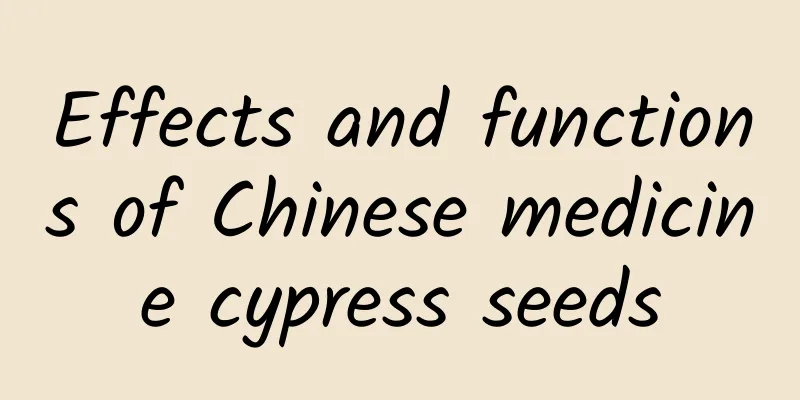The efficacy and function of purple-backed golden disc grass

|
Purple-backed golden disc grass is a common type of traditional Chinese medicine. It has many different functions and can regulate some diseases of the human body. Let us now learn about its specific functions. [Other names] Broken Blood Dan, Bone Grass, Lime Vegetable, Nine Flavor Grass, Sanyu Grass, Sanxue Dan, Tuixue Grass, Sanxue Grass [Source] Medicinal material source: the whole herb or root of the Lamiaceae plant. [Original form] Purple-backed golden plate, annual or biennial herb, more than 10-20cm tall. The stem is usually erect, rarely procumbent, often branched from the base without basal leaves, and covered with sparse soft hairs all over. Stem leaves are petiolate; leaf blades are broadly elliptic or obovate-elliptic, 2-4.5cm long, 1.5-2.5cm wide, and covered with profuse hairs on both sides. The lower part of the cyme is far apart, and the terminal pseudospike is gradually dense upward; the bracts are small, ovate to broad lanceolate; the calyx is campanulate, with 10 veins, 5 calyx teeth, nearly equal; the corona is light blue or blue-purple, rarely white or white-green, with dark stripes, the tube is 8-11mm long, with a hairy ring near the base, the rim is nearly two-lipped, the upper lip is short, 2-lobed, the lower lip is extended, 3-lobed, the middle lobe is fan-shaped, the stamens are 4, didynamous, and extended; the disk is annular. The nutlets are oval-triangular, with reticular wrinkles on the back, and the symphysis is 3/5 of the length of the fruit bearing. The flowering period is from April to June in the eastern part of my country, and from December to March of the following year in the southwestern part; the fruiting period is from May to July in the former, and from January to May in the latter. [Habitat distribution] Ecological environment: Growing in grasslands, forests and sunny slopes at an altitude of 100-2300m. [Properties] Identification of properties: the whole plant is dark green. The stem is slender and square, covered with soft hairs, often with a sallow base and branches. There are no basal leaves; the stem leaves are mostly wrinkled, and the complete leaves are broadly elliptical or obovate when flattened, 2-4.5cm long, 1.5-2.5cm wide, with obtuse apex, cuneate base, decurrent, irregular wavy round teeth on the edge, ciliate, pubescent on both sides, and the back of the lower leaves is often purple; the petiole has narrow wings, sometimes dark purple. The cyme has many flowers, and the bracts are the same shape as the leaves, gradually getting smaller upwards; the calyx is bell-shaped, with soft hairs on the upper part and the toothed margins; the corolla is lip-shaped, light blue or blue-purple, rarely white or white-green, with soft hairs on the outside and a hairy ring near the base on the inside. The nutlets are ovate-triangular in shape, with reticular wrinkles on the back, and the navel occupies 3/5 of the fruit axis. It has a faint smell and a bitter taste. [Chemical composition] The whole plant contains β-ecdysone, ajugasterone A and B, shachysterone D, etc. 【Nature and flavor】 Bitter; pungent; cold 【Functions and indications】 Clears away heat and detoxifies; cools blood and disperses blood stasis; reduces swelling and relieves pain. It is mainly used for cough due to lung heat, hemoptysis, sore throat, breast abscess, intestinal abscess, bleeding from sores and furuncle, swelling and pain due to falls, bleeding due to trauma, burns due to water or fire, and bites from poisonous snakes. [Usage and Dosage] For oral use: decoction, 15-30g; root or grind into powder. For external use: take appropriate amount and mash it for application. 【Excerpt】 Chinese Materia Medica The above is the relevant knowledge about purple-backed goldenseal grass introduced to you. Through the above article, you can clearly understand that purple-backed goldenseal grass has many benefits and functions for the human body, so you can use purple-backed goldenseal grass to treat some diseases. |
<<: The efficacy and function of lilac
>>: The efficacy and function of purple-backed scutellaria
Recommend
The efficacy and function of Amaranth
The traditional Chinese medicine Amaranthus is of...
Summer study, please check out these tips for eye protection
Summer vacation is here! How can we arrange our l...
Do you drool a liter of saliva every day? Uncover the mysterious story behind saliva
Have you ever wondered how the saliva that is pro...
Musk is going to build an electric plane, which will be high-end and unique. Will this boast be blown out of proportion?
Elon Musk is a peculiar man and an outlier. The o...
Is it really good for diabetics to drink camel milk?
Compiled by: Gong Zixin We know that people with ...
Medicinal value of water hyacinth
Water hyacinth is a kind of Chinese medicinal mat...
Steps for soaking Lingzhi in water
After drying the wild Ganoderma lucidum, slice it...
The efficacy and function of litchi shell
Only when we understand the main ingredients of a...
Go to bed late and get up late, but get enough sleep for 8 hours! Does it count as staying up late?
It's time for the holidays again, and our ear...
"Milk is cold in nature, and drinking it will damage the spleen and stomach for people with cold body"?
Rumor: "Milk is cold in nature. Drinking it ...
Stop it! If you love picking your nose, be careful not to damage your brain!
Source: Dr. Curious The cover image of this artic...
The efficacy and function of chestnut bark
The medical value of chestnut bark is beyond our ...
It is one of the most dangerous birds in the world, but it has been kept in captivity.
Today we are going to talk about a bird, a beauti...
The efficacy and function of early vine
Early corn has a long history, and until now, ear...
Oops! China is showing off its bridge-building capabilities again...
Your browser does not support the video tag Aroun...









